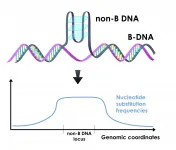(Press-News.org) DNA sequences that can fold into shapes other than the classic double helix tend to have higher mutation rates than other regions in the human genome. New research shows that the elevated mutation rate in these sequences plays a major role in determining regional variation in mutation rates across the genome. Deciphering the patterns and causes of regional variation in mutation rates is important both for understanding evolution and for predicting sites of new mutations that could lead to disease.
A paper describing the research by a team of Penn State scientists is available online in the journal Nucleic Acids Research.
"Most of the time we think about DNA as the classic double helix; this basic form is referred to as 'B-DNA,'" said Wilfried Guiblet, co-first author of the paper, a graduate student at Penn State at the time of research and now a postdoctoral scholar at the National Cancer Institute. "But, as much as 13% of the human genome can fold into different conformations called 'non-B DNA.' We wanted to explore what role, if any, this non-B DNA played in variation that we see in mutation rates among different regions of the genome."
Non-B DNA can fold into a number of different conformations depending on the underlying DNA sequence. Examples include G-quadruplexes, Z-DNA, H-DNA, slipped strands, and various other conformations. Recent research has revealed that non-B DNA plays critical roles in cellular processes, including the replication of the genome and the transcription of DNA into RNA, and that mutations in non-B sequences are associated with genetic diseases.
"In a previous study, we showed that in the artificial system of a DNA sequencing instrument, which uses similar DNA copying processes as in the cell, error rates were higher in non-B DNA during polymerization," said Kateryna Makova, Verne M. Willaman Chair of Life Sciences at Penn State and one of the leaders of the research team. "We think that this is because the enzyme that copies DNA during sequencing has a harder time reading through non-B DNA. Here we wanted to see if a similar phenomenon exists in living cells."
The team compared mutation rates between B- and non-B DNA at two different timescales. To look at relatively recent changes, they used an existing database of human DNA sequences to identify individual nucleotides--letters in the DNA alphabet--that varied among humans. These 'single nucleotide polymorphisms' (SNPs) represent places in the human genome where at some point in the past a mutation occurred in at least one individual. To look at more ancient changes, the team also compared the human genome sequence to the genome of the orangutan.
They also investigated multiple spatial scales along the human genome, to test whether non-B DNA influenced mutation rates at nucleotides adjacent to it and further away.
"To identify differences in mutation rates between B- and non-B DNA we used statistical tools from 'functional data analysis' in which we compare the data as curves rather than looking at individual data points," said Marzia A. Cremona, co-first author of the paper, a postdoctoral researcher at Penn State at the time of the research and now an assistant professor at Université Laval in Quebec, Canada. "These methods give us the statistical power to contrast mutation rates for the various types of non-B DNA against B-DNA controls."
For most types of non-B DNA, the team found increased mutation rates. The differences were enough that non-B DNA mutation rates impacted regional variation in their immediate surroundings. These differences also helped explain a large portion of the variation that can be seen along the genome at the scale of millions of nucleotides.
"When we look at all the known factors that influence regional variation in mutation rates across the genome, non-B DNA is the largest contributor," said Francesca Chiaromonte, Huck Chair in Statistics for the Life Sciences at Penn State and one of the leaders of the research team. "We've been studying regional variation in mutation rates for a long time from a lot of different angles. The fact that non-B DNA is such a major contributor to this variation is an important discovery."
"Our results have critical medical implications," said Kristin Eckert, professor of pathology and biochemistry and molecular biology at Penn State College of Medicine, Penn State Cancer Institute Researcher, an author on the paper, and the team's long-time collaborator. "For example, human geneticists should consider the potential of a locus to form non-B DNA when evaluating candidate genetic variants for human genetic diseases. Our current and future research is focused on unraveling the mechanistic basis behind the elevated mutation rates at non-B DNA."
The results also have evolutionary implications.
"We know that natural selection can impact variation in the genome, so for this study we only looked at regions of the genome that we think are not under the influence of selection," said Yi-Fei Huang, assistant professor of biology at Penn State and one of the leaders of the research team. "This allows us to establish a baseline mutation rate for each type of non-B DNA that in the future we could potentially use to help identify signatures of natural selection in these sequences."
Because of their increased mutation rates, non-B DNA sequences could be an important source of genetic variation, which is the ultimate source of evolutionary change.
"Mutations are usually thought to be so rare, that when we see the same mutation in different individuals, the assumption is that those individuals shared an ancestor who passed the mutation to them both," said Makova, a Penn State Cancer Institute researcher. "But it's possible that the mutation rate is so high in some of these non-B DNA regions that the same mutation could occur independently in several different individuals. If this is true, it would change how we think about evolution."
INFORMATION:
In addition to Guiblet, Makova, Cremona, Eckert, Huang, and Chiaromonte, the research team at Penn State includes Robert S. Harris and Di Chen. The research was funded by the U.S. National Institutes of Health, Penn State Clinical and Translational Sciences Institute, the Penn State Institute of Computational and Data Sciences, the Huck Institutes of the Life Sciences at Penn State, the Penn State Eberly College of Science, the Pennsylvania Department of Health, and the CBIOS Predoctoral Training Program.
A 'biological age' score predicts that being male, overweight, a smoker and having depression all contribute to biological aging, a study published today in eLife reports.
Aging can be measured in different ways. While chronological age is measured by date of birth, scientists have developed a range of measurements to determine our biological age. These include measuring the length of telomeres (little caps on the end of our chromosomes that shorten as we grow older), chemical changes to our DNA (epigenetics), and changes to the proteins and metabolites in our bodies ...
According to the Education Act, schools in the ethnically divided Bosnia and Herzegovina must teach students "democratic ideals in a multicultural society." But according to new research from the University of Copenhagen, the opposite happens: Segregated schools perpetuate ethnic divisions between Croats, Serbs and Bosniaks, making reconciliation after the 1992-1995 wars extremely difficult.
25 years ago, the warring factions in the war in former Yugoslavia signed a peace agreement. Bosnia and Herzegovina, where 100,000 people lost their lives during the war, is now an independent state comprising the Bosnian-Croatian Federation and the Republika Srpska. It is a division that ...
Social conflicts, from policy debates to family disagreements, can easily devolve into angry words and personal attacks. Such heated confrontations, however, seldom resolve disagreements and can entrench opposing views.
A better approach to resolving interpersonal disagreements is to embrace characteristics that psychological scientists associate with wisdom, like intellectual humility, diverse viewpoints, and open-mindedness.
But applying these elements of wisdom can be difficult, especially during confrontations. The trick, according to new research published ...
The global problem of unowned domestic cats, driven by the cats' phenomenal reproductive success, carries significant economic, animal welfare and biodiversity costs. Big-data research led by an expert on veterinary medicine and infectious diseases at City University of Hong Kong (CityU) has found that although more than 80% of cats in Australia were desexed, only a fraction have had surgery before reaching puberty, thus creating a "pregnancy gap". To close this gap and prevent unwanted litters, it is recommended that the age of desexing is before four months.
The research was led by Professor ...
OAK BROOK, Ill. - Breast cancer death rates have stopped declining for women in the U.S. younger than age 40, ending a trend that existed from 1987 to 2010, according to a new study in Radiology. Researchers expressed hope that the findings would raise awareness of breast cancer in younger women and spur research into the causes behind the change.
Breast cancer is the most common non-skin cancer and the second most common cause of cancer deaths in women in the U.S., accounting for 30% of all cancers in women. Although most invasive breast cancers occur in women age 40 years and older, ...
Scientific and public health experts have been raising the alarm for decades, imploring public officials to prepare for the inevitability of a viral pandemic. Infectious epidemics seemingly as benign as "the flu" and as deadly as the Ebola virus provided ample warning, yet government officials seemed caught off guard and ill prepared for dealing with COVID-19. Three future-oriented researchers and policy experts map out an "Epidemiological Blueprint for Understanding the Dynamics of a Pandemic."
COVID Detectives
Researchers around the world have become forensic, Sherlock Holmes-like "consulting detectives" for government officials and public health organizations. Handling tens of thousands ...
In the span of only 15 years, a small academic elite has increased its share of academic citations significantly. In the year 2000, 14 per cent of all citations went to the top one percent of the most cited researchers. New research shows that this figure had risen to 21 per cent in 2015.
The people behind these remarkable findings are senior researcher Jens Peter Andersen, Danish Centre for Studies in Research and Research Policy (CFA) at Aarhus BSS, Aarhus University, and associate professor Mathias Wullum Nielsen (former CFA, now University of Copenhagen). Their examination of almost 26 million scientific papers and four million authors has just been published in the well-established interdisciplinary journal Proceedings of the National Academy of Sciences ...
Animal owners frequently report concerns and worries relating to caring for their animal during the pandemic, new research suggests.
The study, by the University of York, also revealed owners had increased their appreciation of their animals during the first lockdown phase. The notion that people "could not live without" their animals and that they were a "godsend" or a "lifeline" in the pandemic was frequently expressed.
The study has been investigating the role of animals as sources of emotional and physical support during the pandemic. More than 40 per cent of UK households are estimated to own at least one animal.
There was consensus among participants that companion animals constituted a reliable source of support, providing unconditional love, ...
When human cells have to adapt due to a wide variety of external influences, the BAF complex plays a central role because it controls the accessibility of the DNA and thus the information stored in it. In every fifth human cancer, a mutation is found in one of the BAF complex genes. Scientists from the research group of Principal Investigator Stefan Kubicek at the CeMM Research Center for Molecular Medicine of the Austrian Academy of Sciences have investigated this complex in more detail using novel techniques and were able to show how quickly changes in the BAF complex genes influence the accessibility of DNA. The study has now been published in Nature Genetics.
Chromatin is a central component of the cell nucleus and refers to the material that ...
In nature, as in everyday life, we are surrounded by resonance - the phenomenon that describes how each object has a frequency that it prefers to vibrate at. The note of a guitar string and the sound of Big Ben chiming are examples of resonance.
Vibrations near resonance cause strong impacts. Bridges collapse if soldiers march in unison; a kid can 'push' themselves on a swing by moving their legs at the correct rate, and two pendulum clocks on the same table will synchronise. These examples show the enhanced sensitivity given to an object when it is provided with energy at a specific (that is, resonant) frequency. It's no wonder then that physicists and engineers are always looking for ways to use ...






